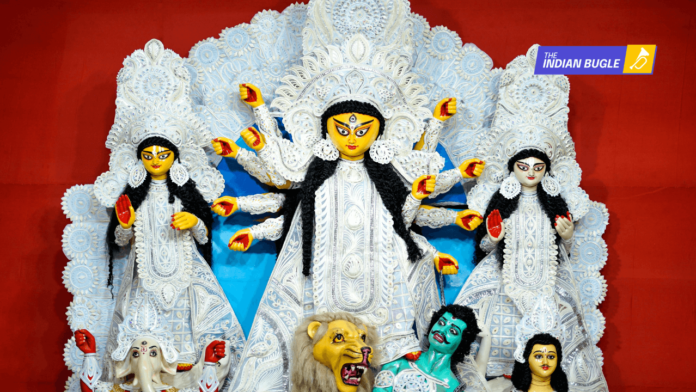Durga Puja in Bengal is not just a festival — it is an emotion, a season, and a way of life. Streets become art galleries, neighborhoods become home, and the beats of the dhak echo in every corner. From the first chants of Mahalaya to the last immersion of idols, Durga Puja is a blend of spirituality, creativity, and community spirit that captures the soul of Bengal.
Shubho Mahalaya — the awakening of the Goddess
The grand curtain-raiser of Durga Puja is Mahalaya, celebrated on the Amavasya before Navratri. Before sunrise, families gather to listen to the powerful recitation of Mahishasura Mardini, filling the air with devotion. Artisans perform the ritual of Chokkhudaan — painting the goddess’s eyes — symbolizing her descent to earth. The idols are then brought into sunlight, believed to give them life. For children, it’s also a time of joy, often marked with firecrackers.
Maha Shashti — the beginning of celebrations (28 September 2025, Sunday)
The sixth day, Maha Shashti, marks the official beginning of the festival. The ritual of Bodhan (invocation of the Goddess) takes place, and from this day, pandals open their doors for the devotees. The atmosphere comes alive with dhak beats, devotional songs, and the fragrance of incense. Durga is worshipped along with her children — Saraswati, Lakshmi, Ganesha, and Kartikeya. Families and friends begin pandal-hopping, admiring the artistry of magnificent structures and idols.
Maha Saptami — Pran Pratishtha and Kola Bou (29 September 2025, Monday)
On Maha Saptami, the seventh day, the rituals deepen. Priests perform Pran Pratishtha, breathing life into the idol through sacred chants. One of the most symbolic traditions is the worship of Kola Bou, a banana plant draped in a sari, bathed in a river, and placed beside Ganesha. Locally known as Ganesha’s symbolic wife, she represents fertility, prosperity, and the nurturing power of nature.
Maha Ashtami — Pushpanjali, Kumari Puja & Dhunuchi Dance (30 September 2025, Tuesday)
Maha Ashtami, the eighth day, is often regarded as the most powerful and divine.
- Pushpanjali: Devotees offer flowers while chanting mantras, and many fast until prayers conclude.
- Kumari Puja: Young girls are worshipped as living embodiments of the Goddess, representing purity and Shakti. The moment is filled with reverence and emotion.
- Dhunuchi Dance: Men and women dance gracefully with dhunuchis (earthen pots filled with burning incense and husks), swaying to the thunderous beats of the dhak.
- Sandhi Puja: Performed at the twilight of Ashtami and Navami, devotees light 108 lamps and offer 108 lotus flowers. This powerful ritual symbolizes the moment Goddess Durga struck down Mahishasura, marking the triumph of good over evil.
Maha Navami — the final battle (1 October 2025, Wednesday)
The ninth day, Maha Navami, commemorates the final phase of the battle between Goddess Durga and Mahishasura. Devotees begin the day with Mahasnan (ritual bath) followed by special prayers. The air carries a bittersweet feeling, for Navami signals both victory and the nearing farewell of the Goddess.
Bijoya Dashami — Sindoor Khela and farewell (2nd October 2025, Thursday)
Bijoya Dashami, the tenth day, is one of the most emotional moments of the festival. Married women perform Sindoor Khela, smearing vermilion on each other’s faces while offering it to the Goddess. This ritual celebrates the essence of womanhood, fertility, and marital bliss. Families gather to offer sweets to the Goddess, seek her blessings, and prepare for her departure. The chants of “Asche bochhor abar hobe” (She will return next year) echo everywhere.
Durga Puja Visarjan — a tearful goodbye
The final act of the celebration is Visarjan — the immersion of the idols in rivers and ponds. Processions filled with music, conch shells, chants, and drums accompany the Goddess on her journey back to her heavenly abode. For devotees, it’s a deeply emotional moment — a goodbye filled with the promise of a grander return next year.
Why Durga Puja in Bengal is unique
Durga Puja in Bengal is a living canvas — from exquisite idol-making and theme-based pandals to soulful dhak beats, community feasts of bhog and sweets, and rituals like Kumari Puja and Dhunuchi dance. It unites faith and art, spirituality and celebration, making it an experience that cannot be described in words alone — it must be lived, seen, and felt.
Durga Puja is not only Bengal’s pride but also a cultural heritage recognized worldwide. It is a festival that embodies the timeless story of good over evil, while also showcasing Bengal’s artistic brilliance, hospitality, and joyous spirit.
Whether it’s hearing the first chants of Mahalaya at dawn, joining the hypnotic rhythm of the Dhunuchi dance on Ashtami, or watching the teary-eyed Visarjan procession, Durga Puja is an experience that stays with you forever.
